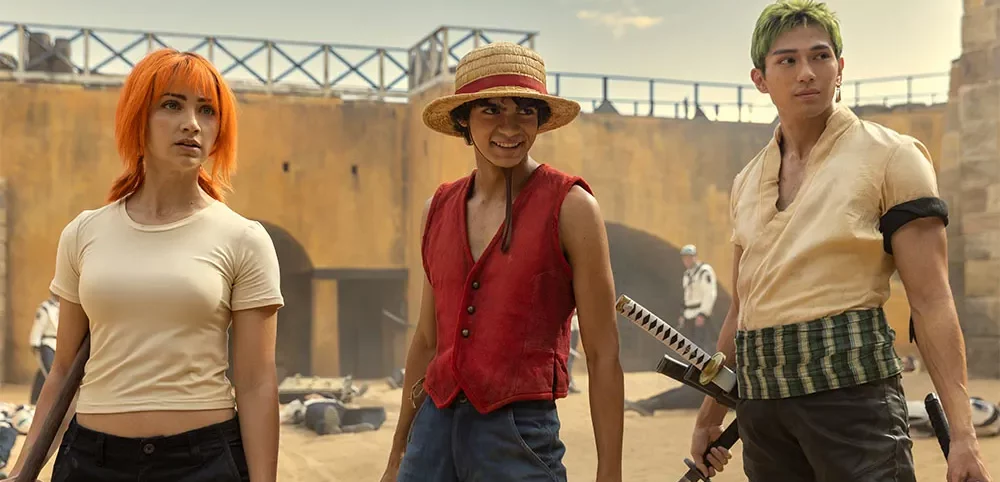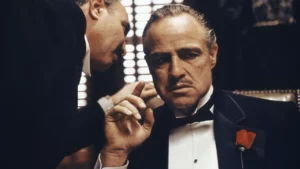
One Piece Live-Action has generated a massive positive response since its global release on Netflix on August 31, 2023. The episodic series is adapted from Eiichiro Oda’s manga named One Piece, who is also the executive producer for the series.
With over 1,000 published chapters and over 100 volumes, the events in One Piece are still ongoing and Netflix has thought on gaining up on the hype. There is no end in sight for the manga that is currently in the finale of the Egghead Saga and fans continue to ask for more background context and cannon.
Continue reading to find out why the One Piece Live-Action series has a 94% audience score on Rotten Tomatoes and why everything is not perfect in the pirate saga.
One Piece Live Action (2023) Cast
- Iñaki Godoy as Monkey D. Luffy
- Emily Rudd as Nami
- Mackneyu as Roronoa Zora
- Jacob Romero as Usopp
- Taz Skylar as Sanji
- Morgan Davies as Koby
One Piece Live-Action series (2023) Plot
Similar to the manga, One Piece Live-Action begins with Captain Gold Roger’s public execution by the Navy. They intended to make an example out of him to discourage piracy, but his last words had the opposite impact. Roger revealed the secret of the One Piece treasure in which he stashed his vast riches, and promised anyone who claimed it wealth, fame, and power.
The series follows the adventures of Monkey D. Luffy on his quest, or rather an obsession, to become the King of the Pirates. He takes to the East Blue Ocean in search of a crew and a map of the Grand Line where the One Piece treasure is hidden. During the episodic journey, he makes new friends and dangerous enemies while viewers get to understand the strange pirate world that is filled with fruits that give supernatural powers and snails for telephones.
Season 1 of the One Piece Live-Action series is about the formation of Luffy’s crew, the Straw Hat Pirates, which includes the master swordsman Roronora Zoro, the intrepid thief Nami, the engineer Usopp, and the crew’s chef Sanji. Flashbacks and flashforwards are used to highlight each character’s motives. However, the storylines have progressed rather swiftly with the introduction of Garp and the early exit of Buggy The Clown.
One Piece Live-Action series (2023) Review
While no adaptation work can be perfect to the source material, it is certainly good to see the actors and directors putting their heart out to give anime fans a show that they will cherish. Godoy is exuberant in the role of Luffy, bringing the unbridled energy characteristic of the anime character with a wide, toothy grin and a jovial personality. Emily Rudd and Mackenyu, who portrayed Nami and Zoro on TV, respectively, have also done a great job in carefully mimicking the voice tones, behavior, and personality of the designated characters.
In the first episode, when Luffy and Zoro meet face-to-face for the first time, fans can feel the tension build between the two. Zoro’s intensely fierce gaze is met with a smile by Luffy, and the lone warrior eventually gets charmed into joining Monkey. Rudd’s portrayal of Nami is on point, acting like the wise elder sister/thief who uses her head instead of fists to solve problems. She is the official ‘plan maker’ for the crew.
The praise for characterization and cast doesn’t end there. Buggy’s introduction in the second episode was wonderful. He held the citizens of Orange City hostage and forced them to see the performance of his crew. The control freak clown, overly conscious of his nose, directed the audience when to laugh or be silent via placards that were used by his crewmate, Mohji. The possessor of the Chop Chop Fruit power also revealed how Shanks betrayed him, a cannon event that will have consequences in the future.
Costumes were taken from the anime and implemented brilliantly in the One Piece live-action series such that it didn’t look corny. The setting for each scene was also captured perfectly, from the field where Luffy and Zoro beat the Marines to the Buggy’s circus that included misfits, monsters, and other freaks. Dialogues assigned to each character fit their overall personality. Also, repetition of O.G. sentences from the anime is used to emphasize a character’s personality, like Luffy’s “I am different from other Pirates” line to Nami or Zoro’s “I like to do my own thing.”
Even though the story has seen some changes, Netflix has been careful not to cut some iconic scenes from the manga. You can find the scene where Zoro eats a riceball that was stomped on by Helmeppo in episode one. Telepathic snail phones can also be seen. Any live-action series would have cut such scenes to get to the point quickly or ‘unnecessary’ items to not hinder the realism of the show but One Piece chose not to.
One Piece Live Action Is Sometimes Too Fast For Its Own Good
Obviously, fitting the lengthy events in the One Piece manga adaptation into eight episodes of 50 minutes each will have drawbacks. The live-action series suffers from a fast-paced plot, with some battles ending abruptly or totally struck out from the script.
Relationships progress rather quickly, and characters are introduced and gone in ‘flashily’, to quote Buggy, who appeared in episode 2 and was defeated by the next episode. Zoro’s fight with Cabaji was short and lame, defeating the other master swordsman by strangling him. A reference to ChouChou, the dog from Orange City, was seen, but there was no fight between him and Mohji’s lion.
The One Piece live-action series comes off as a bit stale because of its breakneck speed in the story. While manga readers will fill in the gaps for themselves, Non-manga readers may find themselves lost.
Now, the part where we talk about the “ugly hag” Alvida. The first antagonist introduced in One Piece manga provides depth to Luffy’s character as a hero while reassessing Koby’s dream to become a ‘good’ Marine. However, the live-action Alvida is less fearsome and speaks in a whisper rather than in an arrogant tone.
Alvida’s character failed to deliver even though she had the spotlight with Luffy for a few minutes. A similar case is for Arlong. The sawshark fish-man talks more in growls and grunts, a shout-out to Killer Croc perhaps, but both these characters were never truly memorable.
In short, some side character portrayals aren’t all that perfect.
The Movie Culture Synopsis
The One Piece Live Action series makes good use of its experienced casting, VFX, story writing, and slick camera work to give a visual treat. Character dynamics have been explored beautifully, and the storylines ending an episode with a cliffhanger leave the viewers wanting more. There is also no overdoing the blood and gore part in the fighting scenes. With the help of multiple camera angles, the action of the Devil Fruit’s powers seems less absurd and more interesting. For example, the camera travels along Luffy’s outstretched arm until it meets its target, making the audience feel the impact.




